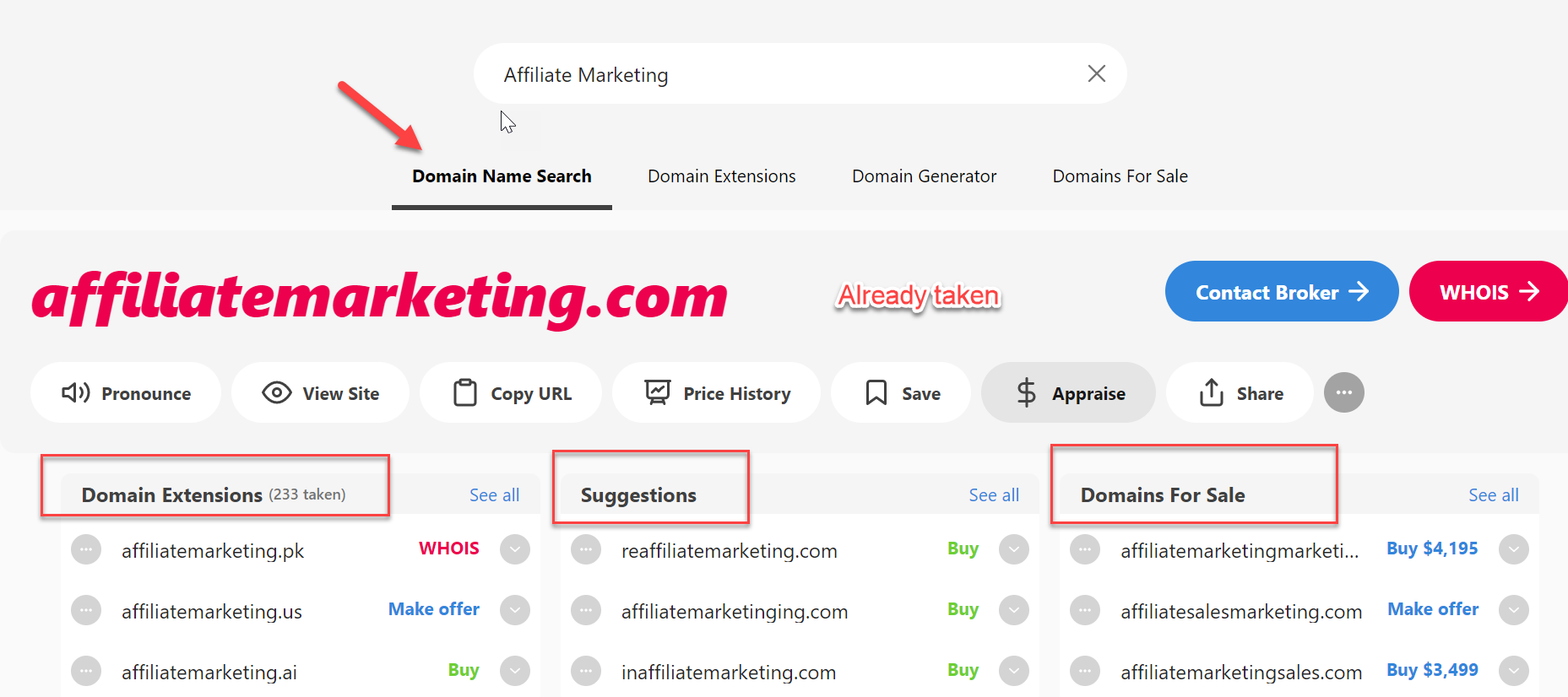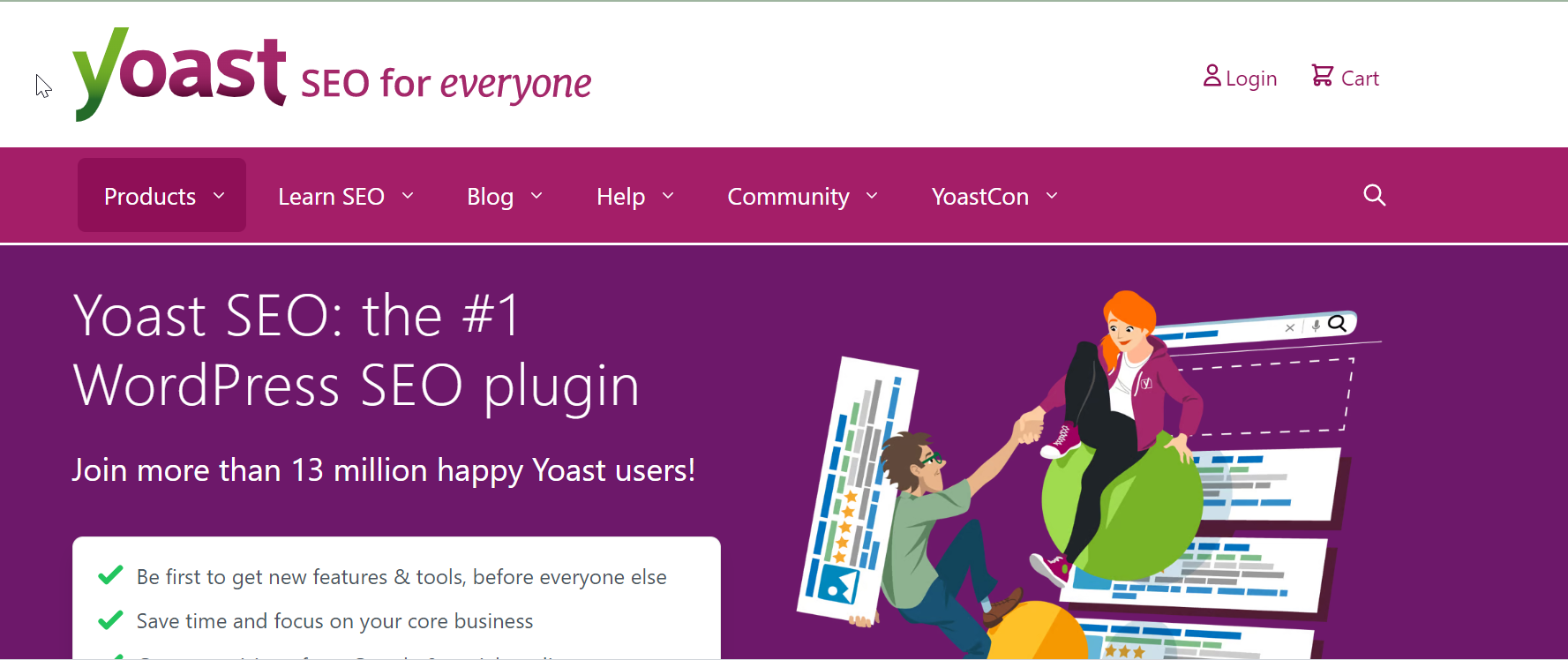Are you tired of trading time for money?
With affiliate marketing, you can earn a commission on products and services you promote, even while you sleep. Using the internet, you can turn your passion into a profitable business and create a passive income stream.
The beauty of this business model is that you don’t have to create your products or handle customer service, making it a low-risk, high-reward opportunity whether you’re a blogger, influencer, or just looking for a flexible side hustle.
Affiliate marketing offers endless opportunities for success.
The following guide will help you set up a WordPress site, build your audience, find affiliate programs, and promote products effectively. Get ready to turn your website into a profitable venture.
Get ready to take your financial future into your own hands and join the millions of people thriving in affiliate marketing.
How to Start Affiliate Marketing on WordPresse
Using affiliate marketing can greatly increase your website’s revenue potential. By partnering with other websites and businesses to promote their products or services, you can earn a commission each time you generate a successful lead or sale.
By following a few straightforward steps and understanding the essentials, you can reap the benefits of this effective marketing technique.
1. Set Up a WordPress Site for Affiliate Marketing
Starting affiliate marketing with a WordPress site is a smart choice for many reasons. It’s user-friendly, flexible, and offers a wide range of customization options.
Here’s a brief rundown of the steps you need to take to set up your WordPress site for affiliate marketing success.
A. Domain Name Selection
A domain name is like the physical address of your website.
It’s the name that users will type into their browser to access your site, so it’s crucial to choose a name that is memorable, easy to spell, and accurately reflects your brand. If you’re building a personal brand, consider using your own name as the domain name.
On the other hand, if you’re building a brand for a business or niche, you can use keywords related to that niche in the domain name. For example, if you’re starting a blog about healthy cooking, you could consider a domain name like “HealthyCookingTips.com.”
If you need help selecting a domain name, use a tool like Instant Domain Search. Simply enter your desired domain name into the search bar, and the site will check its availability. Its color will turn red if the domain name is taken.
Moreover, it will suggest alternative options that are similar or available. You can select the one you prefer and purchase the domain through the site. The process is simple and fast and allows you to secure your domain name quickly to start building your website.
- Find a Reliable Hosting Service
Hosting is a crucial component of having a successful website. It is the foundation for storing all your website files, and choosing a reliable hosting service is critical to ensure that your website operates smoothly and efficiently.
A quality hosting provider should offer fast page loading speeds, robust security measures, and reliable uptime so that your website is accessible to your audience at all times.
Additionally, looking for a hosting provider with a good reputation, 24/7 customer support, and affordable pricing is important.
Hostinger is one such provider that provides shared, cloud, and virtual private server hosting solutions. With over 29 million users worldwide, Hostinger has established a reputation as a cost-effective yet feature-rich hosting provider.
The company provides 24/7 customer support, a 99.9% uptime guarantee, and a 30-day money-back guarantee, making it an excellent option for those looking for a reliable and affordable hosting solution.
C. Install WordPress
WordPress, unlike other content management systems, is easy to use and provides a wide range of customization options. You can install WordPress through your hosting service or download the software from the WordPress website.
Once installed, you can select a theme, customize your website with plugins and widgets, and publish content. With a user-friendly interface and vast customization options, WordPress makes it easy to create a professional-looking website.
Additionally, WordPress is search engine optimized, making it easier for your website to rank well in search results. The platform is also easily scalable, meaning you can start with a basic website and add more features as your business grows.
D. Choose a Theme
A theme determines the look and feel of your website, so it’s important to choose one that is visually appealing, responsive and matches your brand. In addition to free themes, WordPress also offers thousands of paid themes.
Choosing a theme that looks great and provides a smooth and seamless user experience is important. The chosen theme should also reflect your brand and align with your identity.
With WordPress, you have a vast array of options to choose from – both free and paid themes. With thousands of themes available, there’s sure to be one that suits your needs.
The free themes provide a basic design and layout, while paid themes come with advanced features and customizability options.
Whether you choose a free or paid theme, ensure it is responsive and provides a seamless experience across all devices. Your website’s theme can make or break the first impression of your brand, so choose wisely.
E. Install Plugins
Plugins are a powerful tool for web developers and marketers alike. They are small software applications that add extra features and functionality to a website.
They can help you achieve specific marketing objectives, such as increasing your website’s security, optimizing your content for search engines, or tracking affiliate links. Using plugins, you can customize your website and give it an edge over your competition.
Some of the most well-known plugins include Yoast SEO, which helps improve your website’s search engine rankings, Gravity Forms, which simplifies the process of creating forms; and ThirstyAffiliates, which tracks affiliate links and makes them easier to manage.
These plugins can help you streamline your affiliate marketing efforts and maximize your earning potential.
2. Build Your Audience
Building an audience is essential for any affiliate program. You can reach a larger group of potential customers and convert more leads into sales. Additionally, having a loyal audience helps create brand ambassadors who can help promote your products or services.
These steps will give you insight into developing a dedicated audience for your affiliate marketing endeavors.
A. Create Quality Content
Creating relevant, engaging content that provides value to your target audience is the key to attracting and retaining a loyal audience. It includes blog posts, videos, podcasts, or other content that aligns with your niche.
B. Build an Email List
An email list allows you to communicate directly with your audience. This list is crucial to establishing a successful affiliate marketing business. You can collect email addresses through opt-in forms, lead magnets, or by offering incentives for signing up.
C. Utilize Social Media
Social media is a powerful way to grow an audience, reach new customers, and promote your affiliate products.
Select platforms that match your niche and target audience, and use them to share your content, connect with your followers, and promote your affiliate products.
D. Networking with Other Bloggers and Affiliates
Networking is important in building a successful affiliate marketing business. Connect with other bloggers and affiliates in your niche, share content to reach new audiences, and collaborate on projects.
Building relationships with other marketers will help you grow your audience, increase your visibility, and expand your reach.
3. Find Affiliate Programs
Finding an Affiliate Program is necessary to maximize profits, increase brand awareness and strengthen customer loyalty. It allows you to tap into the power of influencers who can share your product and services with their followers.
An affiliate program incentivizes affiliates to promote your business, encouraging them to create content about your products and services.
These steps will help you find an affiliate program aligned with your product and service offerings.
A. Popular Affiliate Networks
Affiliate networks connect affiliates with merchants who offer affiliate programs. Popular affiliate networks include Amazon Associates, Commission Junction, and Shareasale.
Joining an affiliate network gives you access to a wide range of affiliate programs, making it easier to find the right one for your business.
B. Research Products and Services
Before applying to an affiliate program, research the products and services offered by the merchant. Ensure they align with your niche, target audience, and marketing goals. Look for high-quality, in-demand products and offer a good commission rate.
C. Apply to Affiliate Programs
To apply to an affiliate program, you’ll need to apply to the affiliate network or directly to the merchant. Make sure to fill out the application accurately and provide all the information required, such as your website URL, social media handles, and your audience’s description.
D. Reading and Understanding Affiliate Program Terms and Conditions
Before you start promoting a product or service, ensure you fully understand the terms and conditions of the affiliate program. It includes the commission rate, payment schedule, and any restrictions or limitations on how you can promote the product.
Understanding the terms and conditions will help you make informed decisions and avoid potential issues.
E. Promote Affiliate Products
Promotion for affiliate products is necessary to create awareness of the product, drive website traffic, and generate sales.
It can help you reach potential customers through social networks, email campaigns, search engine optimization, and other online marketing techniques.
It also helps build customer relationships by providing valuable content and engaging them on social media platforms.
To effectively market your affiliate products, you can follow these techniques.
4. Understand Your Target Audience
To promote affiliate products successfully, you must deeply understand your target audience. Know their pain points, interests, and preferences, and choose affiliate products that cater to their needs.
A. Choose the Right Affiliate Products
Choose affiliate products that align with your niche, target audience, and marketing goals. Look for high-quality, in-demand products and offer a good commission rate.
B. Incorporate Affiliate Links into Your Content
Affiliate links are the key to earning commissions from affiliate products. Make sure to embed affiliate links into your content in a way that adds value to your audience and doesn’t detract from their experience.
C. Create Product Reviews and Comparisons.
Product reviews and comparisons effectively promote affiliate products. Offer an honest evaluation of the product, highlighting its strengths and weaknesses and explaining how it can benefit your target audience.
D. Utilize Banners and Widgets
Banners and widgets are visual elements you can add to your website to promote affiliate products. Utilizing these elements can help drive traffic and sales to your affiliate products.
Choose banners and widgets that align with your brand and add value to your audience’s experience.
5. Track and Analyze Your Results
Tracking and analyzing results from an affiliate program is essential for gaining valuable insights into optimizing performance.
It provides insight into which campaigns are most effective, where improvements can be made, and what changes should be implemented for maximum profit potential.
You can adjust your strategies quickly with accurate data to get the best return on investment. Tracking and analytics help identify customer trends and preferences, increase customer engagement, and build long-term customer relationships.
By implementing the following steps, you can craft a successful strategy for your affiliate program and optimize it for optimal performance.
A. Set Goals
Setting goals is the first step in tracking and analyzing your results. Defining your objectives helps you keep focused on what you are trying to achieve, and you can measure your progress toward those goals.
If you run an affiliate marketing program, your goal might be to generate a certain number of sales within a given timeframe. This goal can be tracked and analyzed to see if you are on track to achieve it or if you need to adjust your strategy.
B. Track Affiliate Sales
Tracking affiliate sales is an important component of your affiliate marketing strategy. You need to know how many sales you generate, how much commission you earn, and which products perform best.
This information helps you determine the effectiveness of your marketing efforts, and you can make changes to your strategy if needed. Many affiliate networks provide tracking tools, so be sure to use them to keep track of your sales.
C. Analyze Traffic Sources
Analyzing traffic sources is another important aspect of tracking and analyzing your results. You want to know where your traffic is coming from, what channels drive the most traffic, and which channels are not performing well.
It will help you understand the most effective ways to reach your target audience, and you can adjust your strategy to increase traffic from high-performing channels.
D. Improve Your Strategy
Finally, you must use your gathered information to improve your strategy. If you find that a particular product is not selling well, it’s time to reconsider your marketing efforts for that product.
If you discover that a particular traffic source is driving the most traffic and sales, focus on increasing your efforts in that channel. Continuous improvement is key to success in affiliate marketing, and tracking and analyzing your results will help you make the necessary changes to achieve your goals.
6. Avoid the Pitfalls of Affiliate Marketing
Affiliate marketing can be a lucrative venture, but it’s essential to avoid common mistakes to succeed. Some of these pitfalls include the following:
A. Choosing the Wrong Products or Services
When it comes to affiliate marketing, choosing the wrong products or services can be a major mistake. It can lead to low sales and a lack of trust from your audience.
It is important to carefully research the products or services you are considering promoting to ensure they align with your audience’s interests and needs.
Research and understand the products and services before promoting them to ensure the best results for your affiliate marketing efforts.
B. Lack of Relationship Building with Your Audience
Building trust and rapport with your audience is crucial for success. Having no relationship with your audience is a mistake in affiliate marketing. When your audience feels a connection with you, they may purchase through your affiliate links.
A successful affiliate marketing strategy is built on building a relationship with your audience. Engage with your audience regularly by providing valuable content, responding to comments, and offering helpful information.
Ultimately, It will increase their loyalty and lead to long-term success in your affiliate marketing efforts.
C. Lack of Research Regarding Affiliate Programs and Their Terms
The failure to research affiliate programs and their terms is one of affiliate marketers’ most common errors. Before joining an affiliate program, it’s essential to thoroughly research the program and understand the terms, commission structure, and payment schedule.
Failure to do so can result in missed earnings and a lack of understanding of the program’s policies. You should read the fine print, ask questions, and understand the program’s requirements to maximize your earnings and avoid unpleasant surprises.
Remember, researching affiliate programs and their terms is crucial to your affiliate marketing success.
D. Ignoring Trends and Changes in the Industry
Remember, staying up to date with industry trends and changes is crucial for success in affiliate marketing. The industry is constantly evolving, and it’s essential to keep up with the latest developments to stay ahead of the competition.
Regularly reading industry blogs and websites, attending conferences and events, and networking with other affiliate marketers can help you stay informed and make necessary adjustments to your strategy.
Inadequate planning can result in outdated strategies, missed opportunities, and decreased earnings.
Wrapping Up
Starting affiliate marketing on your WordPress site can help you monetize your content and earn extra income. By following the steps outlined in this guide, you can get started on your affiliate marketing journey and see success in no time.
To recap, you must choose a niche, find the right affiliate programs, create valuable content, and track and analyze your results. Remember to stay updated with industry trends and changes and build a relationship with your audience.
With these tips, you’ll be on your way to earning commissions and making your affiliate marketing venture a success.
Take the plunge and start your affiliate marketing journey. With proper research, strategy, and effort, anyone can be successful in this field. Take the first step today and earn money from your website or blog.












